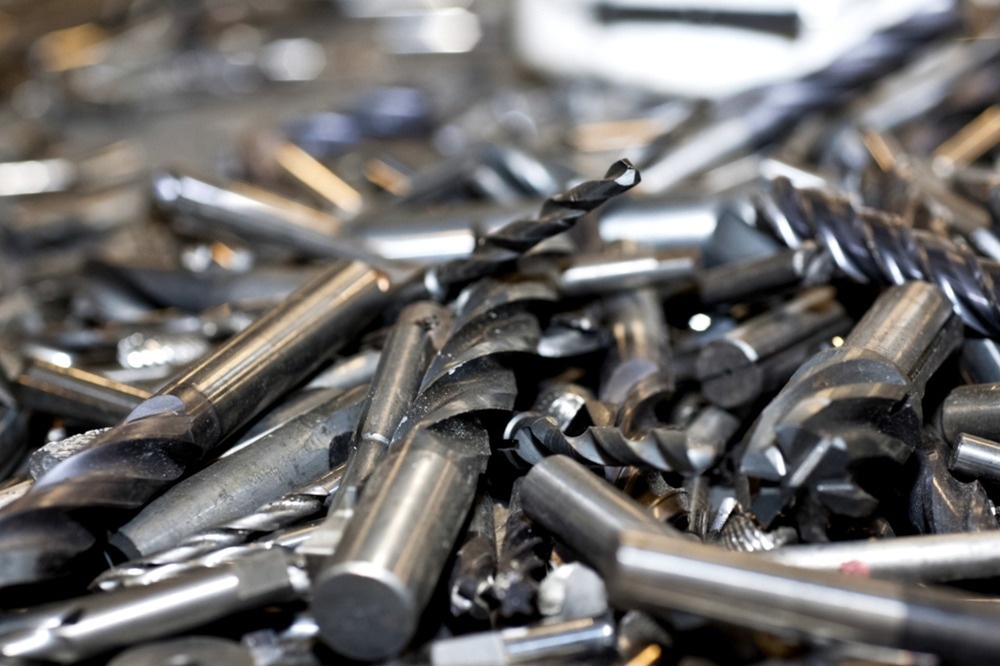Updated by Reginald Davey 10/07/23
Tungsten is a widely used transition metal in a number of industries with the symbol W and atomic number 74. It is solid at standard room temperature. This article will explore its properties and material applications.

Image Credit: hlopex/Shutterstock.com
Introduction
Tungsten is a key industrial metal. Found nearly exclusively as a compound with other elements, tungsten is a rare metal on Earth. First identified in 1781 and isolated in 1783, tungsten is found in ores such as wolframite and scheelite.
A hard, brittle metal, tungsten is difficult to work. Possessing high thermal and electrical conductivity at high temperatures, tungsten has low vapor pressure. Compared to other metallic materials, tungsten has a high melting point and possesses the highest melting point of all elements on the periodic table.
Found nearly exclusively as a compound with other elements, tungsten has high density which gives it excellent radiation absorption. After chromium, it is the second hardest metal.
Physical Properties
Some of the physical properties of tungsten are as follows:
- The density of tungsten is 19.7 g/cm3
- The tensile strength of tungsten is 980 MPa
- Yield strength: 750 MPa
Thermal properties are listed below:
- The melting point of tungsten is 3410oC (6170oF)
- Boiling point of 59,300oC
- Thermal conductivity of 170 W/(m-K)
- Linear thermal expansion coefficient of 4.5 µm/(m·K)
Electrical and magnetic properties:
- Electrical resistivity of 52.8 52.8 nΩ⋅m.
- Magnetic susceptibility of Tungsten is +59e-6 cm^3/mol.
| Properties |
Metric |
Imperial |
| Density |
19.27 g/cm³ |
0.70 lb/in³ |
| Melting point |
3410°C |
6170°F |
Mechanical Properties
The mechanical properties of tungsten are outlined in the following table.
| Properties |
Metric |
Imperial |
| Tensile strength |
1725 MPa |
250 ksi |
| Elastic modulus |
400 GPa |
58000 ksi |
| Hardness |
300 |
300 |
Forming
Before forming, tungsten should be preheated at 675°C (1247°F).
Applications
Tungsten is the heaviest known element with a biological role, used by some bacteria in enzymes to convert carboxylic acids to aldehydes.
Various lighting and furnace applications use tungsten due to its high melting point. Many old-style incandescent light bulbs used tungsten, but this was phased out in favor of other materials due to decreased energy efficiency in these lightbulbs.
Due to tungsten having the highest melting point of all metals, tungsten is widely used as an alloying element to strengthen other metals. Many high-temperature applications utilize tungsten alloys, such as high-temperature furnace heating elements and arc-welding equipment.
The petroleum, mining, and metal-working industries make extensive use of tungsten carbide due to its superior hardness. Key applications include drilling and cutting tools. Furthermore, ultra-high speed “painless” dental drills have been developed using tungsten carbide.
Fluorescent lighting commonly uses calcium/magnesium tungstates. The thermal expansion coefficient value of tungsten is almost same as that of silicon, thus using the tungsten in brazed mounts for silicon diode chips. Tungsten rings produced by the jewelry industry are highly lustrous.
The military uses tungsten in kinetic energy penetrators. Usually, these are alloys of tungsten and either iron, cobalt, or nickel. This is due to the problematic radioactive properties of depleted uranium. Tungsten alloys have also been used in missiles, grenades, and shells to produce supersonic shrapnel.
Tungsten is also commonly utilized in the chemical industry in forms such as tungsten oxide for ceramic glazes and crystal tungstates for use as scintillators for nuclear medicine and physics. SCR catalysts in coal power plants make use of tungsten oxide.
In Summary
Tungsten is a critical metal in multiple industries. Beneficial properties such as the extremely high melting point and good tensile strength of tungsten makes it an ideal choice for many applications which require high strength, and for this reason it is usually alloyed with other metals to improve their properties.
More from AZoM: Tungsten Ditelluride ( WTe2 ) - Properties
References and Further Reading
Material-properties.org (website) Tungsten – Strength – Hardness – Elasticity – Crystal Structure [online] Available at:
https://material-properties.org/Tungsten-mechanical-properties-strength-hardness-crystal-structure/
Royal Society of Chemistry (website) Tungsten [online] rsc.org. Available at:
https://www.rsc.org/periodic-table/element/74/Tungsten
Disclaimer: The views expressed here are those of the author expressed in their private capacity and do not necessarily represent the views of AZoM.com Limited T/A AZoNetwork the owner and operator of this website. This disclaimer forms part of the Terms and conditions of use of this website.